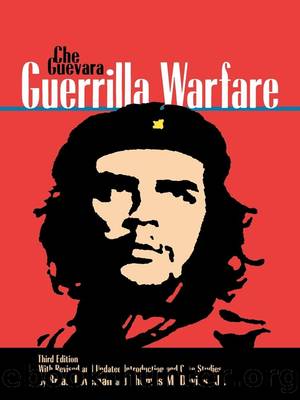Guerrilla Warfare by Guerrilla Warfare (SR Books 1997)

Author:Guerrilla Warfare (SR Books, 1997)
Language: eng
Format: epub
ISBN: 9781461637141
Publisher: Rowman & Littlefield Publishers
Published: 2013-06-26T16:00:00+00:00
While some analysts might question whether the last part of this statement is a revisionist interpretation of the Venezuelan Communist partyâs (and the guerrillasâ) views in the 1960s and 1970s, it was clear by the late 1970s that democratic values and reformist programs had been adopted by Petkoff and most of his ex-comrades. Few people remained who saw the 1960s and early 1970s insurgencies as other than a strategic error, although Juan Vicente Cabezas, el comandante Pablo, could still imagine reopening guerrilla fronts if a Pinochetazo or Videlazo occurred in Venezuela.25
When President Caldera (1969â74) legalized the Communist party, established diplomatic relations with the Soviet Union, gave amnesties to the ex-guerrillas (including the release of Petkoff from prison), and pacified Venezuela, his initiatives anticipated the outcome of the guerrilla struggles in Central America in the 1980s and 1990s. Likewise, the decision by Petkoff, Pompeyo Márquez (MAS), Alfredo Maneiro (late-1970s leader of Causa-R), and others to create social democratic and democratic socialist movements to promote their visions for political change provided examples that would be followed elsewhere in the hemisphere. Rejecting the viability of the guerrilla movements of the 1960s, Maneiro declared at the end of the 1970s: âBroadening and deepening democracy are the ideological commitments of Causa-R . . . democratizing the municipal structure of Caracas, seeking the unity of the left. . . . [My hope] is that some force arises that galvanizes the frustration of this country, of this people, to break the co-dominion of Acción Democrática and COPEI. If that doesnât happen, we may see a âMexicanizationâ of Venezuela.â 26 Joined by other populist, reformist, and Marxist parties, including the Venezuelan Communist party, the Movimiento Electoral del Pueblo (MEP, which had split from AD), and MIR (which merged with MAS in 1988), the Venezuelan left disassociated itself from armed struggle, revolutionary socialism, and anticapitalism. âRenovatedâ long before perestroika, the left was not threatened (indeed, perhaps vindicated) by the end of the cold war in contrast to insurgents in El Salvador, Guatemala, Colombia, and Peruâand Nicaraguaâs Sandinista government.
Not until 1994 did the co-dominion of AD and COPEI over the presidency end. MAS, allied with seventeen other parties and movements, helped elect Rafael Caldera, COPEI founder and now âindependentâ leader of Convergencia. MAS became part of the government; Causa-R remained a leftist opposition party with growing influence. Not all ex-guerrillas and revolutionaries wished to forgetâor at least to suppressâthe ideological and political âerrorâ of guerrilla struggle in emulation of the Cuban Revolution. And not all of them believed, like Juan Vicente Cabezas, that ânos derrotaron porque somos unos pendejosâ (they defeated us because weâre fools).27 But well before perestroika and the collapse of the Soviet Union transformed the still-militarized left in Latin America, the Venezuelan left had taken a more reformist and constitutionalist approach to politics and social change.28
Download
This site does not store any files on its server. We only index and link to content provided by other sites. Please contact the content providers to delete copyright contents if any and email us, we'll remove relevant links or contents immediately.
| Africa | Americas |
| Arctic & Antarctica | Asia |
| Australia & Oceania | Europe |
| Middle East | Russia |
| United States | World |
| Ancient Civilizations | Military |
| Historical Study & Educational Resources |
The Light of Days by Judy Batalion(1064)
First Platoon: A Story of Modern War in the Age of Identity Dominance by Annie Jacobsen(904)
Stalin's War: A New History of World War II by Sean McMeekin(861)
The Pacific War 1941-1943 by James Holland(803)
Walk in My Combat Boots by James Patterson(765)
The American War in Afghanistan by Carter Malkasian(743)
Victory's Price (Star Wars) by Alexander Freed(735)
The Vietnam War: An Intimate History by Geoffrey C. Ward & Ken Burns(723)
Blood and Ruins: The Great Imperial War, 1931-1945 by Richard Overy(687)
Operation Pedestal by Max Hastings(683)
Concepts of Space by Jammer Max;(667)
Cold War (Alexander King Book 2) by Bradley Wright(662)
Extreme Fitness by Chris McNab(654)
The Madman Theory by Jim Sciutto(652)
Flying Tiger by Samson Jack(635)
World War II Infantry Fire Support Tactics by Gordon L. Rottman(612)
Pathfinders by AL-KHALILI JIM(611)
Panzerkrieg by Mike Syron(601)
Hitler’s Pre-Emptive War: The Battle for Norway, 1940 by Henrik O. Lunde(585)
